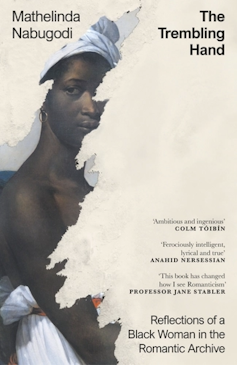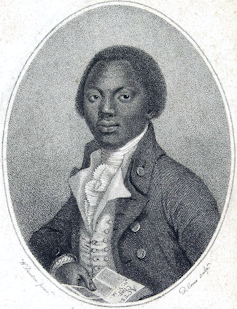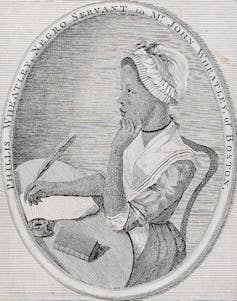According to one strand of history, slavery was abolished when Europeans found their conscience. According to another, it was abolished when it stopped being profitable. Both approaches tend to underplay the significance of Black resistance.
In a revolution that upended ideas about white superiority, the enslaved Black people of the French Caribbean colony Saint-Domingue liberated themselves to create Haiti, the first free Black nation in the Americas. The country was established in 1804, after more than a decade of armed struggle. This historic victory is part of a long series of violent rebellions that regularly shook the Caribbean islands and undermined the transatlantic slave economy.
These rebellions helped make the “slavery question” one of the most contested political issues of its time. Philosophers and statesmen balanced the wrongs of enslavement against the huge profits to be made for individual merchants and for nations as a whole. One after the other, European nations abolished first the trade in enslaved people and later slavery itself.

Looking for something good? Cut through the noise with a carefully curated selection of the latest releases, live events and exhibitions, straight to your inbox every fortnight, on Fridays. Sign up here.
Yet, even in abolition, European nations kept a close eye on their rivals. Britain’s abolition of the slave trade was followed by the creation of a West Africa Squadron of the Royal Navy. Its task was to interrupt the trade of other nations by capturing their slave ships and “liberating” their African captives.
These “liberated Africans” were given the choice of working for the Royal Navy or contributing to Britain’s colonisation of Sierra Leone. None of them were allowed to return home.
Read more:
Three graphic novels that address the history of slavery – and commemorate resistance
While this was going on, romanticism spread throughout Europe. It was a movement that affected every aspect of culture – art, literature, music, philosophy, science and politics. It centred on the idealisation of human freedom in all its forms. Old monarchies were to be swept away by democratic revolutions, stale aesthetic forms by sublime feeling, constrictive gender norms by free love.

Penguin
The romantic drive for freedom is generally interpreted in relation to the French Revolution and the Industrial Revolution. Both symbolise a shift of power from the old nobility to the new bourgeoisie (or middle classes) and a concurrent shift from agrarian to urban economies. Romantic freedom is rarely read in the context of the slavery question.
My new book, The Trembling Hand, addresses this omission. It explores how enslavement shaped European culture in the late 18th and early 19th centuries. I trace how profits made from slavery supported literary work. I analyse how writers absorbed and refracted ideas about Africans that emerged in the public debate around slavery. Above all, I try to recover the presence of Black people, hovering at the edges of the archive.
How do we teach this history?
The links between ongoing Black insurrection in the Caribbean and the romantic obsession with freedom were felt by writers and artists at the time. But they have been obscured by the ways in which this period has traditionally been taught in schools and universities.

Wiki Commons
Today, the status quo is beginning to shift. In response to calls to decolonise and diversify the curriculum, a new canon of Black romantic writing is beginning to be taught. It’s centred on a handful of authors, especially Phillis Wheatley and Olaudah Equiano, as well as the unknown author of the novel The Woman of Colour (1808). Their presence in the curriculum is definitely an improvement – yet it also raises some problems.
To study Black writing of the romantic period inevitably means to study the history of slavery. This is because the only Afro-diasporic people who wrote in English in the 18th and 19th centuries had acquired the language in context of the transatlantic slave economy. It is very hard, if not impossible, to find a Black bildungsroman, gothic romance, or epic poem.
This is a historical fact. Yet it also means that only focusing on works published by Black authors risks playing into the notion that Black people’s only contribution to history was as “slaves”. This erases the multifaceted ways in which Afro-diasporic peoples affected the course of European history in the 18th and 19th centuries. Not only as “slaves” but also as cultural agents in their own right.
This points to the problem of the archive: its gaps and silences, but also its violent distortions.
Many of the archives that we have access to were created by enslavers. They had a vested interest in perpetuating the slave system even as it was being challenged by Black rebels and abolitionists. They threw all their rhetorical force at demonising Black people so as to justify enslavement.

National Portrait Gallery
Literature, alongside art, philosophy and the social and natural sciences contributed to spreading these ideas. These writings were instrumental in shaping public understanding about race, enslavement and empire.
We need to understand how literary writers contributed to constructing a vision of Britain as an imperial power entitled to subjugate foreign peoples and extract their resources.
How does the brutal violence of colonisation come to seem like a reasonable activity for a civilised nation to engage in? How does the idea that white Europeans have a “natural” right to rule over the whole world become widely accepted? Or the idea that people with a darker skin tone are born to serve? Or the idea that being a European power involves having colonies outside of Europe?
These questions prompt us, as readers interested in decolonising and diversifying the teaching of English literature, to turn our gaze on white authors. Especially those major authors whose work had an “impact” on their society. In addition to studying marginalised voices, we need to interrogate the ideas about race that have been created and propagated through canonical literature.
As these works become part of our national heritage, for example by being selected to be taught in schools, so the racial prejudice they harbour become wired into our own minds. Some of the racist ideas that I find in the historical archive are intimately familiar from my own experience.
That’s why I set out to write a new history of romanticism, one that reckons with the impact of the transatlantic slave economy on British culture – an impact so strong that it still resonates today.
This article features references to books that have been included for editorial reasons, and may contain links to bookshop.org. If you click on one of the links and go on to buy something from bookshop.org The Conversation UK may earn a commission.






